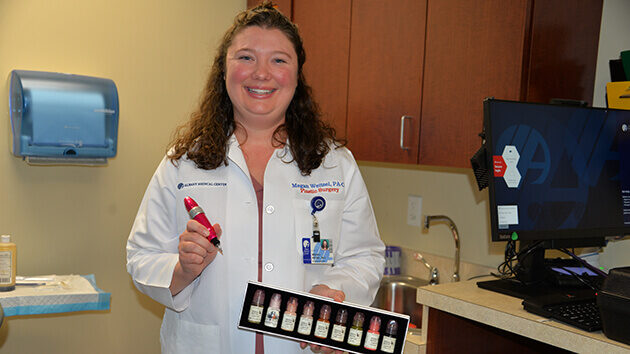Medical Tattoos: The Final Step in Reconstruction Surgery After Breast Cancer

The treatment plan for each woman’s breast cancer diagnosis is determined by a number of factors, including the stage of the cancer, where it originated, and how far it has spread. While a lumpectomy and medication may be all that’s needed to clear the cancer for some women, others with more advanced cancer may require a mastectomy followed by reconstructive surgery, chemotherapy, and radiation.
For those who have had either a single or double mastectomy, areola tattooing – the art of recreating a natural looking nipple and areola through the use of custom mixed pigments and advanced tattooing techniques – is often the final step in the reconstruction process.
“For many women, it represents closure, giving them back a sense of wholeness that goes beyond aesthetics,” said Physician Assistant Megan Weitzel, who is specially trained in medical tattooing. “Seeing natural-looking areolas instead of scars helps patients feel complete and helps them regain a sense of normalcy,” she added.
October is Breast Cancer Awareness Month.
Fully covered by insurance, medical tattooing is done as an outpatient procedure in the plastic and reconstructive surgery offices at Albany Medical Center. It typically takes one to two hours, depending on whether one or both breasts are being tattooed. A referral from the patient’s breast surgeon is helpful, but not necessary.
According to Weitzel, patients should wait four to six months after their final breast surgery before considering areola tattooing. “Waiting allows the skin to recover, scars to mature, and swelling to go down,” she explained. “This also ensures that the tattoo will have the best outcome in terms of placement and color retention.”
Once patients decide to pursue areola tattooing, Weitzel works with them to determine the type that is best for them:
- 3D nipple areola tattooing, which uses different tints to give the appearance of a three-dimensional nipple after it has been removed as part of a mastectomy.
- Areola tattooing after nipple reconstruction, which restores the appearance of the areola after the nipple has been reconstructed by the plastic surgeon.
- Pigment loss adjustment, which corrects the pigment loss around the nipple that is common after breast or gender affirmation surgery.
For all types of tattooing, Weitzel works in partnership with the patient to match their skin tone and preferences, then custom blends pigments. For 3D tattoos, she creates a three-dimensional effect that mimics the natural color and texture of the areola and nipple, restoring their appearance on the new breast.
Most patients experience only mild discomfort and the recovery process is similar to that of getting a tattoo anywhere else on the body.
Weitzel has completed more than 100 medical tattoo procedures since she began performing them in 2016. As a physician assistant, she also sees post-operative breast cancer patients and assists plastic surgeons in the operating room on hand and face trauma cases, skin cancer surgeries, and pediatric surgeries.
Weitzel noted that for many patients undergoing breast reconstruction, receiving an areola tattoo is their first experience with tattooing. “Understandably, this can bring feelings of uncertainty or nervousness,” she said. “As a provider, I feel it’s important to create a calming environment, taking time to explain the process, answer any questions, and reassure patients about the safety and artistry involved. Our goal is to make this final step of their reconstruction journey as comfortable as possible, helping them feel empowered and confident in their new appearance.”
For more information or to schedule a consultation, call 518-262-2229.
Learn more about Women's Health.